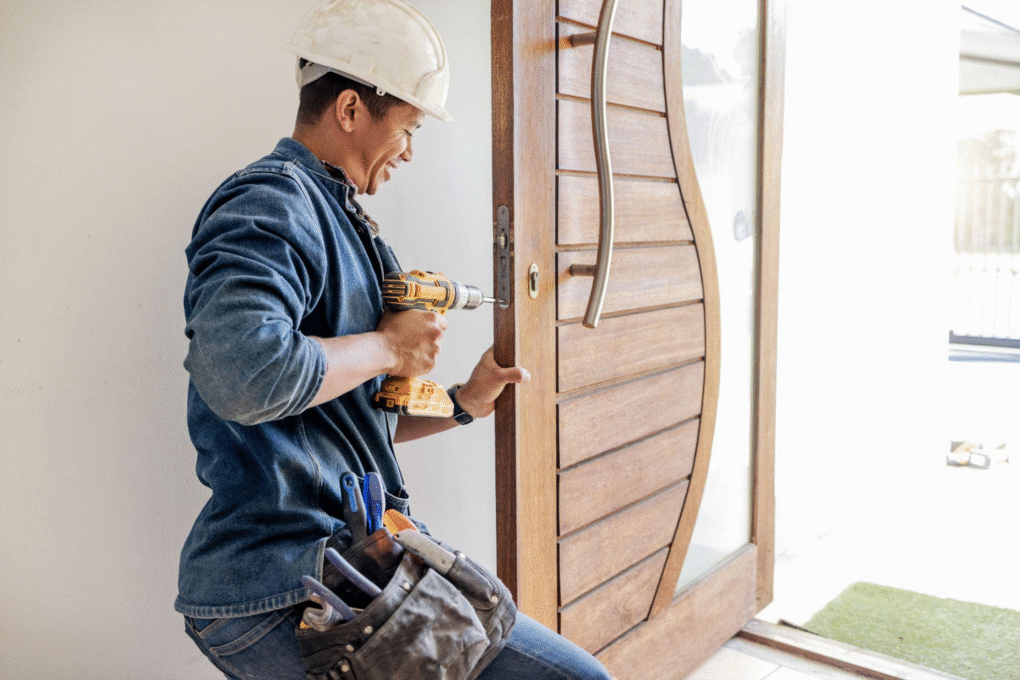
Door installation is a critical home improvement project that requires thoughtful planning and attention to detail. Whether you’re upgrading your patio door, replacing an old entryway, or installing interior doors, several factors come into play to secure success. Material selection, size accuracy, insulation properties, and professional expertise are all essential components of the process.
Table of Contents
- Understanding Door Types and Their Uses
- Key Considerations Before Installing Doors
- Step-by-Step Guide to Professional Door Installation
Imagine stepping into a home where every door feels sturdy, stylish, and perfectly suited to its purpose. Whether it’s welcoming guests through an elegant front entry or enjoying seamless access to your backyard patio, well-installed doors make all the difference. Doors are more than just functional elements – they’re an integral part of your home’s design and energy efficiency.
However, not all door installations are created equal. Poorly installed doors can lead to a host of problems, including drafts, security risks, and higher energy bills. Many homeowners find themselves overwhelmed by the complexity of the process, from selecting the right materials to securing proper alignment. Navigating these challenges often requires understanding the nuances of proper door installation in Calgary, which secures that every detail is addressed with care and precision.
When you are thinking of upgrading your space, it can save you time, money and effort to know what key considerations and steps are involved. That could be the right material choice all the way to achieving a flawless fit, and a lot in between. Luckily, due to the assistance of experienced professionals, it has never been so easy to attain perfect outcomes. So, what makes each type of door special and how to make sure your installation project will run smoothly? Let us find out!
Understanding Door Types and Their Uses
Not all doors are created equal. Each type serves a specific purpose, whether it’s enhancing curb appeal, improving energy efficiency, or providing seamless access to outdoor spaces. Understanding the different types of doors available can help you make an informed decision for your home.
Entry Doors – The First Impression
Your front door is often the first thing visitors notice about your home. It’s not just a functional element but also a statement piece that reflects your style. Entry doors are typically made from durable materials like wood, fiberglass, or steel to withstand daily wear and tear while offering security and insulation.
- Wood: Offers a timeless look but requires regular maintenance to prevent warping or rotting.
- Fiberglass: Resists moisture and temperature changes, making it ideal for harsh climates.
- Steel: Provides excellent security and energy efficiency but can be prone to dents.
Patio Doors – Bridging Indoors and Outdoors
Patio doors are designed to create a smooth transition between your indoor living space and outdoor areas. They’re often larger than other doors and feature glass panels to maximize natural light. Sliding and French-style patio doors are the most common options, each with unique benefits:
- Sliding Doors: Space-saving and easy to operate, perfect for smaller homes.
- French Doors: Offer a classic, elegant look with dual swinging panels that open wide.
Interior Doors – Functionality Meets Design
Interior doors may not face the elements, but they play a crucial role in dividing spaces while maintaining flow. These doors come in various styles, such as panel, flush, or bi-fold designs, and are often chosen based on their ability to blend with your home’s decor.
Specialty Doors – Tailored Solutions
For unique needs, specialty doors like pocket doors, barn doors, or storm doors offer tailored solutions. Pocket doors slide into the wall, saving space, while barn doors add rustic charm. Storm doors provide an extra layer of protection against weather extremes, making them a practical addition in regions with unpredictable climates.
| Door Type | Best For | Key Features |
| Entry | Front-facing entrances | Security, insulation, design |
| Patio | Outdoor access | Large glass panels, smooth operation |
| Interior | Dividing rooms | Soundproofing, lightweight |
| Specialty | Unique needs | Space-saving, weather protection |
Choosing the right door type depends on its intended use, your home’s layout, and your personal preferences. By understanding these differences, you can narrow down your options and select a door that complements both your lifestyle and your home’s architecture.
Key Considerations Before Installing Doors
Before diving into the installation process, it’s crucial to lay the groundwork for success. Proper planning secures that your new doors not only look great but also perform optimally for years to come. Here are some key factors to keep in mind:
Assessing Your Home’s Needs
Every home is unique, and so are its door requirements. Start by identifying the purpose of the door you’re installing. Are you looking to improve energy efficiency? Enhance security? Or simply refresh your home’s appearance? Understanding your priorities will guide your decisions throughout the process.
For example, if energy savings are a priority, consider doors with high insulation ratings. If security is a concern, reinforced materials like steel or multi-point locking systems may be worth the investment.
Measuring for the Perfect Fit
One of the most common mistakes in door installation is incorrect measurements. A door that’s too small or large can lead to drafts, difficulty opening, or even structural issues. To avoid these problems:
- Measure the height, width, and depth of the door opening twice for accuracy.
- Check the frame for signs of damage or wear that might need repair before installation.
- Account for clearance space to secure smooth operation once installed.
If you’re unsure about taking measurements yourself, consulting a professional can save time and prevent costly errors.
Budgeting Wisely
Door installation involves more than just the cost of the door itself. Factor in additional expenses such as:
- Labor costs for professional installation
- Hardware upgrades (e.g., handles, locks, hinges)
- Finishing touches like paint, stain, or weatherstripping
While it might be tempting to cut corners, investing in quality materials and skilled labor often pays off in the long run through reduced maintenance and enhanced performance.
Step-by-Step Guide to Professional Door Installation

Installing a door might seem straightforward, but it’s a process that requires precision and expertise. Even a small misstep can lead to issues like poor alignment, drafts, or compromised security. Here’s a step-by-step guide to help you understand what professional door installation entails – and why it’s often best left to the experts.
Step 1 – Preparation is Key
Before any installation begins, proper preparation sets the stage for success. This involves:
- Removing the Old Door: Carefully dismantle the existing door without damaging the surrounding frame or walls.
- Inspecting the Frame: Check for signs of rot, cracks, or warping. A damaged frame can compromise the new door’s fit and functionality.
- Cleaning the Area: Remove debris, dust, and old hardware to create a clean workspace.
This step secures that the new door has a solid foundation to work with. If the frame needs reinforcement or replacement, address this before proceeding.
Step 2 – Taking Accurate Measurements
Even if you’ve already measured the opening, double-check the dimensions after removing the old door. Measure the height, width, and depth at multiple points to confirm consistency. Small discrepancies can lead to gaps or binding once the door is installed.
Professionals often use specialized tools to secure pinpoint accuracy, which is one reason their expertise can make a big difference in the final result.
Step 3 – Installing the New Door
With everything prepped, it’s time to install the new door. Here’s how professionals approach this critical phase:
- Positioning the Door: Carefully place the door into the frame, securing it’s level and plumb. Use shims to stabilize it temporarily.
- Securing the Frame: Attach the door frame using screws or nails, starting at the hinge side to maintain alignment.
- Testing Operation: Open and close the door several times to check for smooth movement. Adjust hinges or shims as needed.
For patio doors or entry doors with glass panels, additional care is taken to seal gaps and prevent air leaks. Weatherstripping and caulking are applied around the edges to enhance insulation.
Step 4 – Adding Finishing Touches
The final steps focus on aesthetics and functionality:
- Hardware Installation: Attach handles, locks, and hinges, securing they’re aligned and operate smoothly.
- Painting or Staining: If the door requires finishing, apply paint or stain evenly for a polished look.
- Final Inspection: Conduct a thorough review to secure everything is secure, functional, and visually appealing.
While DIY enthusiasts may attempt door installation themselves, even minor errors can lead to long-term problems. That’s why many homeowners opt for professional services, where attention to detail secures every aspect of the process is handled with care.
Final Thoughts: Transforming Your Space with the Right Doors
Doors are not only a practical attribute – they offer you a chance to enlarge the personality, effectiveness, and habitation of your residence. Whether it is the inviting beauty of a front entry door or the smooth transition of a patio door, all doors are crucial in defining your experience of the space. Investing the time to select the appropriate doors and ensuring the professional installation, you can make your home look and feel like one coherent, comfortable, and distinctive place.
